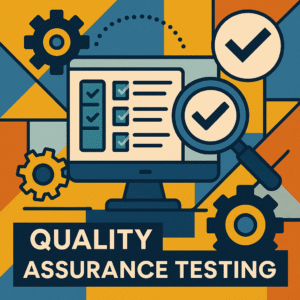Unlocking the Secrets of Successful Test Automation: A Practical Guide
Last Updated: August 19, 2025
Ready to transform your QA process? Discover how CloudQA’s intelligent, codeless platform can help you implement these secrets and achieve automation success. Get a Demo today.
Table of Contents

Introduction: Beyond the Buzzwords
Test automation is a cornerstone of modern software development, promising faster releases, higher quality, and greater efficiency. Yet, many organizations struggle to realize its full potential, often hitting roadblocks that turn promising initiatives into costly failures. The difference between success and failure isn’t about buying the most expensive tool; it’s about understanding the foundational principles—the “secrets”—that successful teams live by.
With over a decade of experience in the test automation space, we’ve identified the core strategies that consistently lead to a high return on investment and a resilient QA process. This guide will move beyond the buzzwords to reveal these practical secrets, providing you with an actionable blueprint for building an automation strategy that not only works but thrives.
Secret 1: Start with a Clear “Why” – The Strategy-First Approach
The single biggest secret to success is knowing what you want to achieve before you write a single test. Many teams dive headfirst into automation without a clear strategy, a mistake that almost always leads to wasted effort.
Why It’s a “Secret”: It seems obvious, but the pressure to “just start automating” often causes teams to skip this critical planning phase. They focus on the “how” (writing scripts) before defining the “why” (the business goals).
How to Implement It: Before you begin, your team must answer these questions:
- What is our primary goal? Is it to reduce the time for regression testing, increase test coverage for critical modules, or enable faster developer feedback?
- What does success look like? Define clear, measurable metrics. For example, “Reduce manual regression testing time from 40 hours to 8 hours” or “Increase automated test coverage of our payment API from 20% to 90%.”
- What is the scope? Clearly define which applications, modules, and test types are in scope for the initial phase.
A well-defined strategy acts as your north star, guiding every decision you make and ensuring your automation efforts deliver real, measurable business value.
Secret 2: Don’t Try to Automate Everything – The Art of Prioritization
A common pitfall is the ambition to achieve 100% automation. This is not only impractical but also a poor use of resources. The secret is to be strategic and selective, focusing your efforts where they will have the greatest impact.
Why It’s a “Secret”: The allure of “full automation” is strong, but experienced teams know that some tests are simply not good candidates for automation.
How to Implement It: Use a risk-based approach to prioritize what to automate. Focus on:
- High-Value, Repetitive Tasks: The best candidates are tests that are run frequently, are time-consuming to perform manually, and are prone to human error. Regression suites are a classic example.
- Business-Critical Workflows: Automate the user journeys that are most important to your business, such as user login, product checkout, or key feature interactions.
- Data-Driven Tests: Tests that need to be run with many different data sets are perfect for automation.
Conversely, avoid automating tests that are exploratory in nature, require human intuition (like usability testing), or are for features that are unstable and change frequently.
Secret 3: Choose the Right Tool for the Team, Not Just the Task
The market is flooded with automation tools, each claiming to be the best. The secret is that the “best” tool is the one that best fits your team’s specific context, including their skills, your application’s technology, and your development processes.
Why It’s a “Secret”: Teams often get seduced by a tool’s impressive feature list without considering the most important factor: the people who will have to use it every day.
How to Implement It:
- Assess Your Team’s Skillset: If your team is composed of manual QA testers and business analysts with limited coding experience, a complex, code-heavy framework is destined to fail. In this case, a codeless or low-code platform would be a far better fit.
- Consider Your Application: Ensure the tool has robust support for the technology your application is built on.
- Prioritize Integration: The tool must seamlessly integrate with your existing ecosystem, especially your CI/CD pipeline and test management software.
- Conduct a Proof of Concept (POC): Never buy a tool based on a sales demo alone. Shortlist two or three options and conduct a POC to see how they handle your real-world testing scenarios.
Secret 4: Treat Your Test Code Like Production Code
For automation to be a long-term asset, the test scripts and frameworks must be treated with the same rigor and discipline as your application’s production code.
Why It’s a “Secret”: Test automation is often seen as a secondary activity, leading to sloppy, poorly designed test code that quickly becomes a maintenance nightmare.
How to Implement It:
- Use Version Control: All test scripts and related assets should be stored in a version control system like Git.
- Implement Code Reviews: Have team members review each other’s test scripts to ensure they are clean, efficient, and adhere to established best practices.
- Design for Maintainability: Write modular, reusable test components. Avoid hardcoding data and use clear, descriptive naming conventions. This investment in clean code pays massive dividends in the long run by making your test suite easier to debug and update.
Secret 5: Make Data-Driven Decisions with Robust Reporting
Automation without clear reporting is a black box. You might be running thousands of tests, but if you can’t easily understand the results, the effort is wasted. The secret is to have a reporting system that provides actionable insights, not just a pass/fail status.
Why It’s a “Secret”: Many teams focus solely on test execution and neglect the crucial final step: analyzing and communicating the results in a meaningful way.
How to Implement It: Your reporting solution should provide:
- High-Level Dashboards: For stakeholders to get a quick overview of quality trends.
- Detailed Test Logs: For testers and developers to quickly diagnose the root cause of a failure. This should include screenshots, video recordings, and console logs.
- Historical Trend Analysis: Track metrics like pass/fail rates over time to identify flaky tests or areas of the application that are becoming less stable.
Secret 6: Integrate Early and Run Often with CI/CD
The true power of automation is unlocked when it is fully integrated into your CI/CD pipeline, providing continuous feedback to your development team.
Why It’s a “Secret”: Some teams keep automation as a separate, manually-triggered process, which severely limits its benefits. Running tests continuously is what transforms automation from a simple testing task into a strategic quality assurance process.
How to Implement It:
- Trigger Tests Automatically: Configure your CI server (e.g., Jenkins, GitLab CI) to automatically run your regression suite every time a developer commits new code.
- Create Fast Feedback Loops: The goal is to inform developers of a potential issue within minutes, not hours or days. This allows them to fix bugs while the context is still fresh in their minds.
- Gate Your Builds: Implement quality gates where a code change cannot be promoted to the next stage (e.g., from staging to production) unless the automated tests pass.
Secret 7: Democratize Testing with a Codeless Approach
One of the most powerful modern secrets is that you don’t need a team of elite coders to succeed with automation. Codeless platforms have “democratized” testing, allowing the entire team to contribute to quality.
Why It’s a “Secret”: The traditional mindset is that automation is purely a developer’s domain. Successful modern teams understand that empowering subject matter experts (like manual QA and business analysts) to build tests leads to better and more business-aligned automation.
How to Implement It: By adopting a codeless tool, you can:
- Leverage Functional Expertise: Allow the people who know the application best to create the tests.
- Reduce Bottlenecks: Free up your developers from being the sole owners of test automation.
- Increase Collaboration: Create tests that are readable and understandable by everyone on the team, fostering a shared sense of ownership over quality.
Conclusion: Automation as a Mindset, Not Just a Project
Successful test automation is not a project with a start and end date; it’s a cultural shift. It’s about embracing a mindset of continuous improvement and shared responsibility for quality. The secrets we’ve discussed are not complex technical tricks but foundational principles: plan strategically, prioritize intelligently, choose tools wisely, and empower your entire team. By internalizing these secrets, you can build a resilient, high-impact automation strategy that accelerates delivery and drives business success.
Frequently Asked Questions (FAQs)
- Q1: What is the most important “secret” for a team just starting out?
- Starting with a clear “why” (Secret 1) is absolutely critical. Without a defined strategy and measurable goals, your initiative is likely to drift and fail to show value.
- Q2: Can we achieve 100% test automation?
- While technically possible, it’s not a desirable or practical goal. Some tests, like exploratory and usability testing, rely on human intuition and are best left to manual testers. Focus on achieving high automation coverage for your most critical and repetitive test cases instead.
- Q3: How do we convince management to invest in the right tools and training?
- Build a business case that focuses on ROI. Use the metrics you established in your strategy (Secret 1) to show how automation will reduce costs (e.g., hours saved on manual testing), increase revenue (e.g., faster time-to-market), and reduce risk (e.g., fewer bugs in production).
LIKE THIS POST SHARE IT WITH YOUR FRIENDS
RECENT POSTS
Guides

How To Select a Regression Testing Automation Tool For Web Applications
Regression testing is an essential component in a web application development cycle. However, it’s often a time-consuming and tedious task in the QA process.

Switching from Manual to Automated QA Testing
Do you or your team currently test manually and trying to break into test automation? In this article, we outline how can small QA teams make transition from manual to codeless testing to full fledged automated testing.

Why you can’t ignore test planning in agile?
An agile development process seems too dynamic to have a test plan. Most organisations with agile, specially startups, don’t take the documented approach for testing. So, are they losing on something?

Challenges of testing Single Page Applications with Selenium
Single-page web applications are popular for their ability to improve the user experience. Except, test automation for Single-page apps can be difficult and time-consuming. We’ll discuss how you can have a steady quality control without burning time and effort.

Why is Codeless Test Automation better than Conventional Test Automation?
Testing is important for quality user experience. Being an integral part of Software Development Life Cycle (SDLC), it is necessary that testing has speed, efficiency and flexibility. But in agile development methodology, testing could be mechanical, routine and time-consuming.






